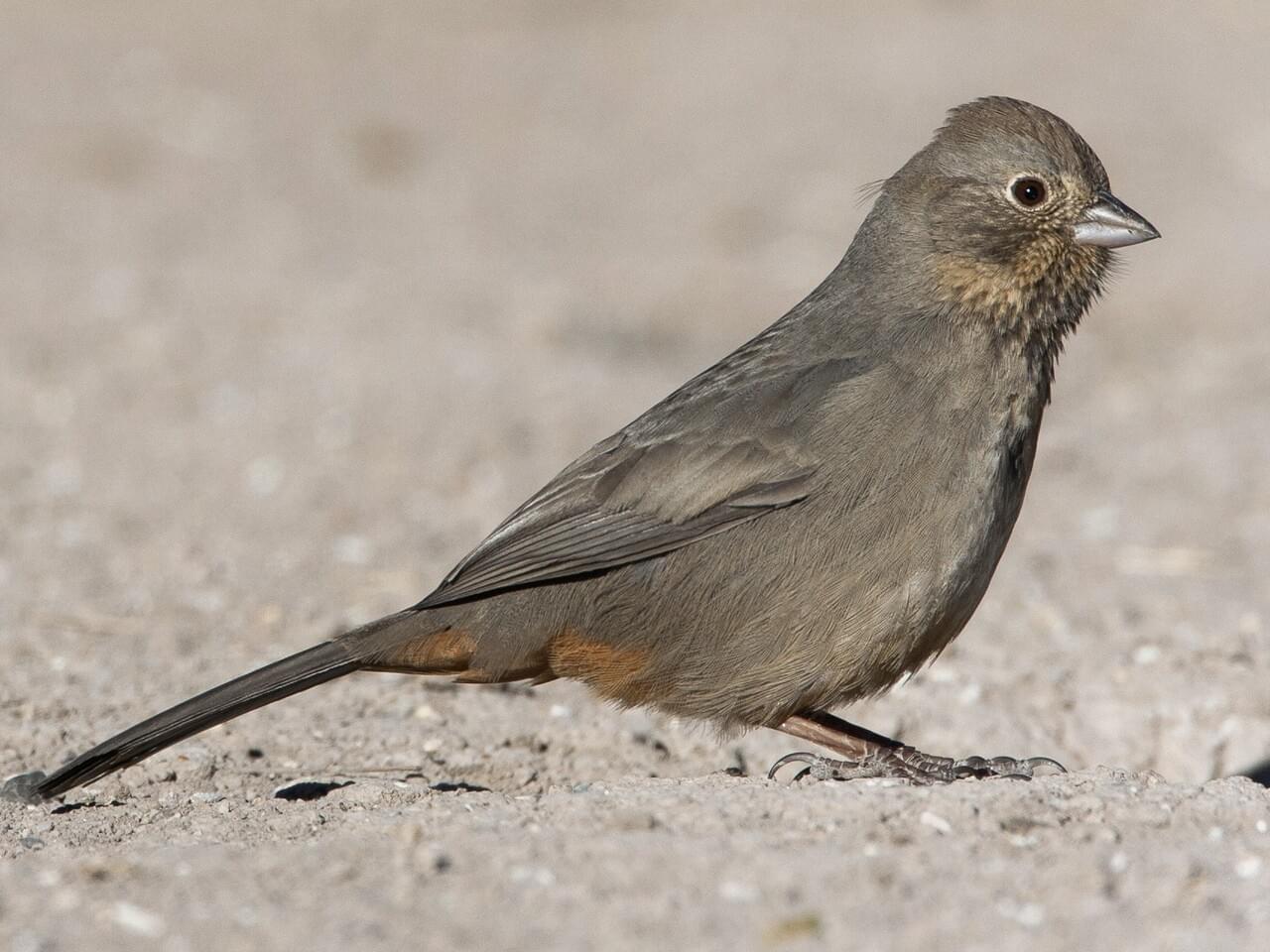 Photo ©
Larry Meade
Photo ©
Larry Meade
Canyon Towhee
Regional Species
Canyon Towhees keep a low profile across their range in the Desert Southwest. These big, warm-brown sparrows are common on the ground and underneath shrubs in a variety of scrubby habitats, but they easily blend into the background. Look for a fairly long-legged, long-tailed sparrow that’s the same color as the dirt, with warm rusty brown under the tail. They look very similar to the widespread California Towhee (the two were once considered the same species), but their ranges don’t overlap.
Range

Habitat
In the United States, Canyon Towhees live in desert grasslands and rocky and shrubby areas, often along arroyos, mesquite thickets along streams, and suburban settlements. They also occur at higher elevations, particularly in Mexico, where you may find them in desert grasslands, pinyon-juniper woods, and pine-oak forests.
Food
Canyon Towhees eat mostly small seeds of grasses, sorrel, chickweed, pigweed, and lupine, as well as berries including elderberry and poison oak. They eat small invertebrates, too, including grasshoppers and other insects, millipedes, snails, and spiders. At feeders them eat milo (sorghum), millet, black oil sunflower seeds, and rolled oats.
Behavior
Canyon Towhees stay fairly close to the ground and often run rather than fly. When they do fly, they fly short distances and are slow but maneuverable. Abert’s and Canyon Towhees occur in the same areas and use very similar habitats and foods—an unusual situation for closely related species. When foraging in leaf litter, Canyon Towhees use the double-scratch method shared by many towhees and sparrows. This consists of a quick jump forward and an even quicker jump back, scratching with the feet to overturn leaves and expose food items. Canyon Towhees are monogamous and form very long-lasting (often lifelong) pair bonds. They typically forage alone or as a pair, although they don’t defend territories vigorously and often tolerate other Canyon Towhees if they approach.
Nesting
The female builds a bulky nest of grass and plant stems lined with fine grasses, horse-hair, or even pieces of old rags. The nests often incorporate flowers including mustards and daisies. The finished nest is about 4 inches across, and the cup is 2.5 inches across and 3 inches deep.
Appearance
Typical Sound
© Bob McGuire | Macaulay Library
Size and Shape
Canyon Towhees are large sparrows with fairly long tails, chunky bodies and short rounded wings. The bill is short and thick at the base, and the legs are long.
Color Pattern
Overall, the Canyon Towhee is about as plain brown as birds come. They have warm rusty undertail coverts, a buffy throat and a hint of a reddish crown.
Plumage Photos
Similar Species
Abert’s Towhees overlap with Canyon Towhees in Arizona, so look for Abert’s Towhee’s black patch around the base of the bill, and its slightly larger size. Abert’s Towhee also has a pale bill and dark eyes instead of the Canyon Towhee’s grayish bill and light brown eyes. California Towhees look very similar to Canyon Towhees, but their ranges do not overlap, so checking where you are is the most straightforward way to tell them apart. Rufous-crowned Sparrows overlap with Canyon Towhees, but they are considerably smaller and more strongly marked than Canyon Towhees—grayer on the face and breast, with streaked backs.
Did you know?!
- Canyon Towhees are desert creatures and they pay attention to water supplies. They can nest twice a year, timing their attempts to coincide with winter and summer rains, which produce a flush of plant material and insects..
- Canyon Towhees’ seemingly simple songs contain lots of variation and have been well studied. In 1968, two scientists described this variation colorfully: “At its worst the song is a dull series of chips, but at its best it is a gay, sustained jingle to be compared with that of a titmouse. A male whose dawn singing has been dull and perfunctory during late winter and early spring will become transformed into a polished singer when his mate disappears to incubate….”




